'Core Values
The boys in American Hardcore had a grubbiness made for radio even if their songs weren’t. Paul Rachman’s documentary chronicles the evolution and demise of hardcore punk in the early ’80s, a movement that was fueled by the British and homegrown scenes, the election of Ronald Reagan, and the need of an outlet for kids who “were pissed off but didn’t know why.”
Hardcore was always a response to the snooze of mainstream rock. “Journey, the Eagles, Fleetwood Mac they were all great bands for what they do,” says Keith Morris, formerly of Circle Jerks and Black Flag. “But when you hear it over and over—and over again, you’re going to just want to...vomit. Or jump off the nearest cliff.” Not that vomiting, most likely, wasn’t a factor in hardcore. Rachman, long a filmmaker of the underground scene and video director for bands such as Gang Green and erstwhile Washingtonians Bad Brains, captures the fast-as-Flash pace of the genre, opening with the Brains’ “Pay to Cum” while a mostly black-and-white montage shows split-second glimpses of chaotic-show stills and crudely decorated band posters and logos. The birth of hardcore took the ’70s punk of such bands as the Ramones and the Avengers and put it on crack: Songs were short, loud, and usually indecipherable, with an emphasis instead on pushed-to-the-limit speed. As Impact Unit’s Dicky Barrett says, “The less it was a song, the more we loved it.” Solos were forbidden, being associated with the pop rock they were rebelling against.
Rachman was inspired to make this movie by credited writer Steven Blush’s book, American Hardcore: A Tribal History. It covers, albeit a bit disjointedly, the timeline of how the scene spread across the country: first appearing in Southern California and later catching on in cities like D.C., Chicago, Boston, and, naturally, New York. In between grainy, 20-plus-year-old footage of shows performed in church basements and friends’ homes, there’s a who’s-who parade of commentators including locals Henry Rollins, Ian MacKaye, and Bad Brains’ Paul “H.R.” Hudson as well as Gwar’s Dave Brockie and Moby (yes, that Moby). Each recalls the craziness of the shows, heavy on moshing and general violence. The first time Brockie experienced hardcore live, he says, his panicked impression was, “Oh my God! People are killing each other!” Because the performers contributing here made it out alive, their stories and glimpses of the chaotic shows are pretty entertaining—as are the shots of the parallel ’80s universe, all Members Only jackets and feathered hair.
Hardcore was also rather self-inclusive, and the film emphasizes its DIY approach. The bands put out their own records—MacKaye talks of reproducing album covers by hand—and booked their own shows, often squatting in abandoned buildings for out-of-town gigs. There were no illusions about getting on the radio (“That’s like a black guy saying, ‘I’m going to be president of the Ku Klux Klan.’ No, you’re not!”). It was a male-dominated world, but a few girls were part of the scene, too, though mostly as fans or handling bookkeeping and such.
Most everyone here agrees that hardcore punk died in the mid-’80s. MacKaye, for one, felt that the violence associated with it had become unacceptable. Hair metal was moving in, and audiences were losing interest. Perhaps what’s most amusing about Rachman’s doc is the kids-these-days! attitude of now-adult, former rebels, ranting against unnamed artists implied to be, say, Good Charlotte or blink-182: “None of this shit, none of these little fucking spoiled little fucking brats on MTV now with their buses and all that bullshit, and they’re calling that shit punk,” rails the Cro-Mags’ John Joseph. “That ain’t fucking punk.”

